The last issue of NYX: No Way Home comes out this week. I read the first volume of NYX while I was in law school, and if you had told me way back then that I’d have a chance to continue the story of Kiden and her friends, I would have said ‘Rock on!’ and then called you crazy. But hey, I got the chance, and I grabbed it—and so here I am, doing a great deal more than I envisioned even then (I am blessed in many ways, it goes without saying, and thank my lucky stars). Of course, nostalgia aside, I also loved writing NYX because of the characters—who are not superheroes, do not want to be superheroes, would laugh at the idea of spandex and aliens—and who, most fundamentally, just want to be kids. Life is hard enough for Kiden and her friends, but they’ve got guts, and they’re smart, and there’s no lack of compassion in their hearts—especially for each other. One day, hopefully soon, I’ll come back to them for Volume 3. I’ve got the buildings blocks of the story.
But if you really want to get down to basics, the creative team is the main reason I loved working on NYX: No Way Home. John Barber, Michael Horwitz, Kalman Andrasofszky, Sara Pichelli, John Rauch…everyone and anyone who had their hand in this book. So, this week I’m interviewing some of them, and I’m kicking things off with John Rauch, colorist-extraordinaire, who worked miracles with NYX and brought it to life with lovely, wild, vibrancy. I never knew what to expect, but it was always a pleasure discovering the pages after John made them come alive.
Tell folks a bit about yourself—and what, exactly, you do as a colorist.
OK, here goes…my name is John Rauch. I’m a husband, a father of two, and a colorist in what ever time is left in the day. As a colorist, the technical part of my job is to take an inked (or sometimes just penciled) comic book page and basically paint it. The choice of medium and software is left up to me, but I prefer using Adobe Photoshop. The artistic part of my job is to help tell the story. I read the script, examine the artist’s 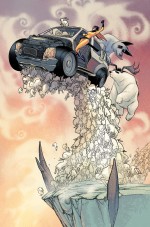 interpretation of what’s written, and I try to expand on what they have started. I choose colors that help create a suitable mood for what’s happening on the page. My personal style comes in to play a little bit, but mostly my techniques change from one book to the next, so I think the way I interpret the story and art through color choices is a big part of what I’d call my style. How I balance my colors with the black and white art, where I draw attention, whether I take a more painterly or simpler flatter approach; these are the things I focus on as a colorist.
interpretation of what’s written, and I try to expand on what they have started. I choose colors that help create a suitable mood for what’s happening on the page. My personal style comes in to play a little bit, but mostly my techniques change from one book to the next, so I think the way I interpret the story and art through color choices is a big part of what I’d call my style. How I balance my colors with the black and white art, where I draw attention, whether I take a more painterly or simpler flatter approach; these are the things I focus on as a colorist.
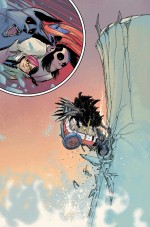
How does one, in general, become a comic book colorist—and did your own journey deviate from the norm? What was your inspiration for doing this?
 Well the most common way I know that people become colorists is by accident. A lot of colorists, including myself, probably thought they’d be pencilers and got derailed at some point. My first coloring break was in high school when I job shadowed at a place called ‘Heroic Age Studios’. They did some comic book coloring, but mostly what was called “separations”. In the 90’s it was very common to get color guides done up with markers, watercolors, or something like that on paper, and send them on to a separator who’s job was to reproduce (read: destroy) the same look on a digital file. Heroic Age offered me an in-house position doing separations and some occasional full coloring and I did this for several years. I suppose my journey might have been easier than some because I started in an environment where certain technical standards had already been established and I didn’t have to discover them on my own. They already had computers set up with Photoshop, files prepared in formats ready to be colored, etc. I will say that my “training” there was very minimal, but definitely helped me to get started. In the way of inspiration, I was just thrilled to be working in comics and making money during high school.
Well the most common way I know that people become colorists is by accident. A lot of colorists, including myself, probably thought they’d be pencilers and got derailed at some point. My first coloring break was in high school when I job shadowed at a place called ‘Heroic Age Studios’. They did some comic book coloring, but mostly what was called “separations”. In the 90’s it was very common to get color guides done up with markers, watercolors, or something like that on paper, and send them on to a separator who’s job was to reproduce (read: destroy) the same look on a digital file. Heroic Age offered me an in-house position doing separations and some occasional full coloring and I did this for several years. I suppose my journey might have been easier than some because I started in an environment where certain technical standards had already been established and I didn’t have to discover them on my own. They already had computers set up with Photoshop, files prepared in formats ready to be colored, etc. I will say that my “training” there was very minimal, but definitely helped me to get started. In the way of inspiration, I was just thrilled to be working in comics and making money during high school.
What kinds of tools do you use, and what’s the process for coloring a comic book—say, for example, NYX?
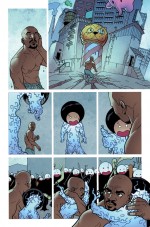 NYX was a very fun book for me to color because it allowed so much freedom in regards to the palettes I chose. Not once do I ever remember having a color scheme dictated to me or shot down after I turned in a page. The rendering style was somewhat similar to the approach used in older animation where the characters and objects the characters interact with are very simple, but the backgrounds have a more hand-painted look. I think the contrast between the two really made it fun to work on and never monotonous. As far as tools go, I stuck with my trusty Photoshop CS3. For those who are familiar with the software,
NYX was a very fun book for me to color because it allowed so much freedom in regards to the palettes I chose. Not once do I ever remember having a color scheme dictated to me or shot down after I turned in a page. The rendering style was somewhat similar to the approach used in older animation where the characters and objects the characters interact with are very simple, but the backgrounds have a more hand-painted look. I think the contrast between the two really made it fun to work on and never monotonous. As far as tools go, I stuck with my trusty Photoshop CS3. For those who are familiar with the software, 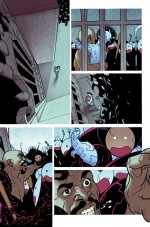 I used all of my own custom brushes because I’m kind of a fanatic for that type of thing. Actually, with nearly every new book I start on, I create a set of brushes specific to that book, that have the grit, texture (or lack thereof) and general feel I think suits the story and the line art. One of the most important parts of my job is to compliment the story and black & white art, rather than showboat or distract from it for my own ego. Sometimes that means going all out and sometimes it means holding back. I just try to find that right balance with each book I do and hope for the best.
I used all of my own custom brushes because I’m kind of a fanatic for that type of thing. Actually, with nearly every new book I start on, I create a set of brushes specific to that book, that have the grit, texture (or lack thereof) and general feel I think suits the story and the line art. One of the most important parts of my job is to compliment the story and black & white art, rather than showboat or distract from it for my own ego. Sometimes that means going all out and sometimes it means holding back. I just try to find that right balance with each book I do and hope for the best.
Any particular pages from the work you’ve been doing that currently stand out as favorites? Can you share some of that art with us, or the names of the projects you’re working on?
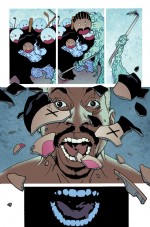 I tend to work on quite a few things at a time, so I’m afraid to mention one project and offend the people I work with on another one I didn’t mention, so let me say up front that I enjoy SOMETHING about every book I’ve had the privelage to work on recently that I can remember. That said, I recently finished the last issue of ‘Patsy Walker: Hellcat’ and it was a boatload of fun and filled a void that is often lacking in modern comics. I also worked on the Ultimate Spiderman Annual with the same artist, David LaFuente and it was just as fun. I’m also just getting started on X-men Origins: Wolverine and it’s looking to be an absolute blast. In the past, Wolverine has been a hard sell to me as a character, but the more I work on him, the more I’m softening up. Of course, that may have something to do with the great teams I’ve been paired up with lately.
I tend to work on quite a few things at a time, so I’m afraid to mention one project and offend the people I work with on another one I didn’t mention, so let me say up front that I enjoy SOMETHING about every book I’ve had the privelage to work on recently that I can remember. That said, I recently finished the last issue of ‘Patsy Walker: Hellcat’ and it was a boatload of fun and filled a void that is often lacking in modern comics. I also worked on the Ultimate Spiderman Annual with the same artist, David LaFuente and it was just as fun. I’m also just getting started on X-men Origins: Wolverine and it’s looking to be an absolute blast. In the past, Wolverine has been a hard sell to me as a character, but the more I work on him, the more I’m softening up. Of course, that may have something to do with the great teams I’ve been paired up with lately.